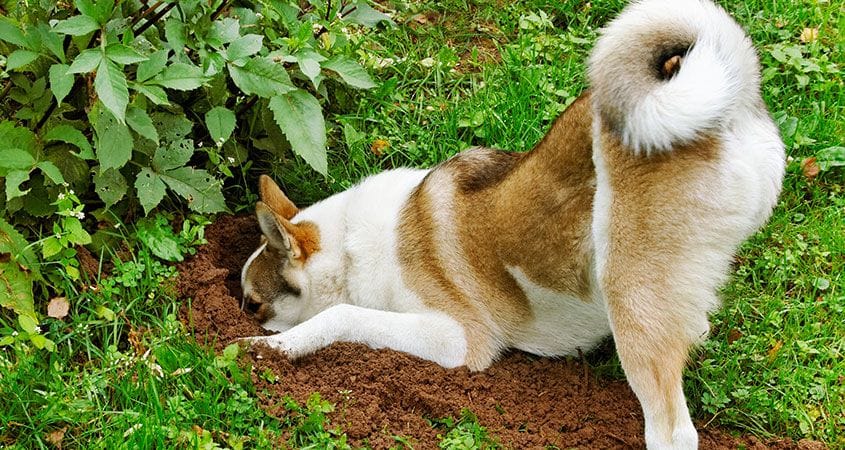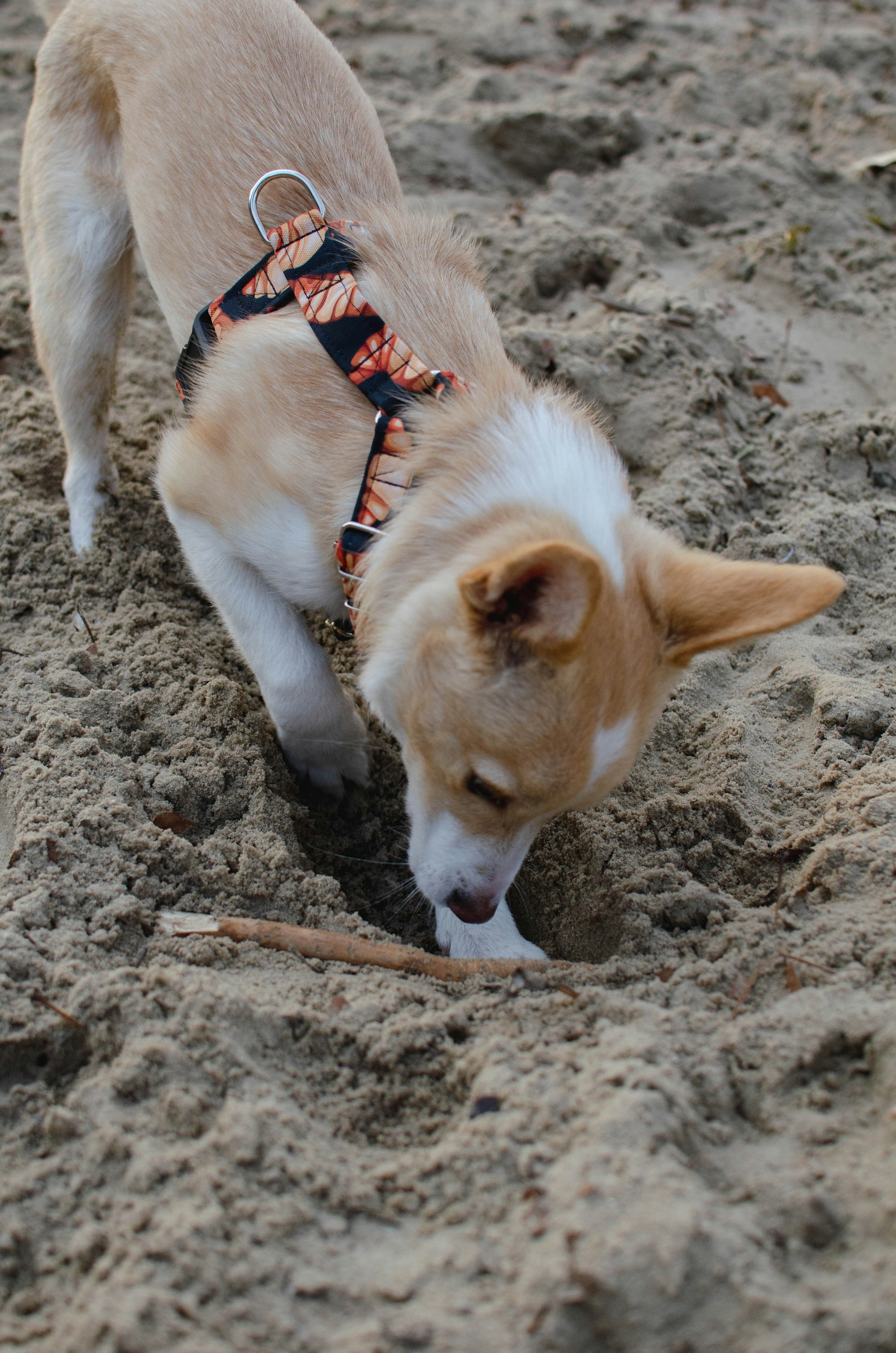Dogs are curious and energetic animals that enjoy exploring and engaging in various activities. One behavior that is innate to many dogs is digging. If your furry friend tends to dig up your garden or yard, you might be looking for a solution. Dog-digging toys provide a great outlet for this natural behavior while keeping your dog entertained and mentally stimulated. Here, we will explore the world of dog-digging toys, their benefits, types, and how to choose the right one for your canine companion.

Why Do Dogs Dig?
Understanding why dogs dig is essential in addressing this behavior. Dogs may dig for various reasons, including:
· Instinct: Digging is an instinctual behavior inherited from their ancestors, such as wolves. It served purposes like creating dens, finding prey, or hiding valuables.
· Boredom: Dogs that lack mental and physical stimulation may resort to digging as a way to entertain themselves.
· Escape: Some dogs may dig under fences or gates to escape confinement or seek adventure.
· Temperature regulation: Dogs might dig to create a cool spot in hot weather or a warm spot during colder seasons.
The Importance of Mental Stimulation
Mental stimulation is crucial for good family dogs' overall well-being. Engaging their minds helps prevent boredom and the development of destructive behaviors. Providing your dog with appropriate mental challenges can alleviate stress, reduce anxiety, and promote a healthier, happier pet. Dog digging toys offer an excellent opportunity to stimulate your dog's mind while satisfying their instinct to dig.
Benefits of Dog-Digging Toys
Dog-digging toys offer numerous benefits for both dogs and their owners. Let's explore some of the advantages they provide:
1. Mental Exercise: Dog digging toys challenge your pet's problem-solving skills and engage their cognitive abilities. By figuring out how to dig or uncover hidden treasures, dogs receive a mental workout that keeps their minds sharp.
2. Reduction of Boredom: Dogs that lack mental stimulation can become bored, leading to undesirable behaviors such as excessive barking, chewing, or digging. Digging toys provide a productive outlet for their energy and curiosity, keeping them occupied and entertained.
3. Physical Exercise: Digging is a physically demanding activity that can provide exercise for your dog. By using their paws, snout, and body to dig, they engage their muscles, promoting overall fitness and well-being.
4. Stress Relief: Digging can be a stress-relieving activity for dogs. It allows them to release pent-up energy, frustration, or separation anxiety constructively. Engaging with digging toys can help your dog relax and unwind.
5. Behavioral Management: Dogs with a natural inclination to dig may target your yard or garden, causing damage. Providing them with appropriate digging toys redirects their behavior to a designated area, protecting your property while satisfying their instinctual needs.
6. Bonding Opportunity: Using digging toys with your dog creates opportunities for bonding and interaction. It strengthens the bond between you and your furry friend as you play together, creating a positive and enjoyable experience for both of you.
Dog-digging toys offer a world of benefits, from mental and physical exercise to stress relief and behavioral management. By providing a positive and engaging outlet for your dog's natural digging instincts, you not only enhance their overall well-being but also protect your yard and garden from unwanted damage.

Types of Dog-Digging Toys
There is a wide variety of dog-digging toys available to cater to different preferences and needs. Here are some popular types:
1. Digging Mats: These mats mimic different textures, such as grass or sand, providing a realistic digging experience for your dog. They are designed to be durable and offer a safe surface for your pet to dig.
2. Bury Toys: These toys have hidden compartments or pockets where you can hide treats, toys, or bones. Dogs enjoy the challenge of uncovering these treasures, simulating the natural hunting instinct.
3. Sensory Digging Boxes: These boxes are filled with materials like shredded paper, fabric, or straw, providing a sensory experience for your happy dog as they dig and explore. They can be particularly appealing to dogs that enjoy tactile stimulation.
4. Interactive Puzzle Toys: These toys require your dog to solve puzzles or manipulate parts to access hidden treats or toys. They provide mental stimulation, encouraging your dog to think and problem-solve while having fun.
5. Ball Pit Digging Toys: These toys consist of a shallow pool or container filled with plastic balls. Dogs can dig, search, and paw through the balls to find hidden rewards or simply enjoy the sensation of digging through the softballs.
Choosing the right type of digging toy depends on your dog's preferences, size, and activity level. Consider their individual needs and interests when making a selection.
Invest in high-quality digging toys and spend quality time engaging with your furry friend, enjoying the endless fun and excitement they provide.
Factors to Consider When Choosing Digging Toys
When selecting digging toys for your dog, keep the following factors in mind:
1. Size and Breed: Consider the size and breed of your dog to ensure the toy is appropriate for their size and strength.
2. Durability: Choose toys made from durable materials that can withstand your dog's digging and chewing habits.
3. Safety: Ensure the toy doesn't have small parts that could be swallowed or pose a choking hazard.
4. Interactivity: Look for toys that offer interactive elements, such as hidden compartments or sensory textures, to keep your dog engaged.
5. Ease of Cleaning: Opt for toys that are easy to clean and maintain to ensure your dog's safety and hygiene.
DIY Dog Digging Toys
If you enjoy DIY projects, you can create engaging digging toys for your dog at home. Some ideas include:
1. Digging Box: Fill a large container with sand or shredded paper and bury treats or toys for your dog to discover.
2. Frozen Toy Excavation: Freeze toys or treats in a container of water, creating an icy excavation challenge for your dog.
3. Treat-Filled Muffin Tin: Fill the compartments of a muffin tin with treats, cover them with tennis balls, and let your dog dig them out.
Remember to supervise your dog while they are playing with DIY digging toys to ensure their safety.

Training Your Dog to Use Digging Toys
Introducing your dog to digging toys and teaching them how to use them can be a rewarding experience. Proper training ensures that your dog understands the purpose of the toys and engages with them safely and enjoyably. In this section, we will provide a step-by-step guide on how to train your dog to use digging toys effectively.
Training Steps
Follow these steps to help your dog become familiar with and comfortable using digging toys:
1. Introduction: Introduce the digging toy to your dog in a calm and quiet environment. Allow them to sniff and investigate the toy at their own pace.
2. Positive Association: Create a positive association with the digging toy by using treats or praise. When your dog shows interest in the toy or approaches it, reward them with a treat and verbal praise.
3. Engagement: Encourage your dog to interact with the toy. You can sprinkle some treats on the surface of the toy or hide treats inside it to pique their curiosity. This will motivate them to dig and explore.
4. Guidance: If your dog is hesitant to engage with the toy, gently guide dog paws towards it and encourage them to dig. Use a playful and enthusiastic tone to make it an enjoyable experience for them.
5. Reinforcement: Continuously reinforce positive behavior. Whenever your dog successfully uses the digging toy, reward them with treats and praise. This positive reinforcement will encourage them to repeat the behavior in the future.
6. Gradual Transition: Gradually reduce your involvement in the training process. Allow your dog to explore and interact with the digging toy independently, reinforcing their independent playtime.
7. Consistency: Be consistent in your training efforts. Set aside dedicated playtime sessions with the digging toy to reinforce the training and help your dog establish a routine.
Best Practices for Using Dog Digging Toys
To ensure a positive and safe experience with digging toys, follow these best practices:

1. Supervision: Always supervise your dog while they are using digging toys. This allows you to intervene if any issues arise and ensures their safety.
2. Appropriate Use: Use the digging toys in designated areas or on surfaces where digging is allowed. Redirect your dog to the designated area whenever they show a desire to dig elsewhere.
3. Rotating Toys: Keep a rotation of different digging toys to maintain your dog's interest. Introduce new toys periodically to provide novelty and stimulation.
4. Toy Variety: Provide a variety of digging toys with different textures, sizes, and features. This keeps your dog engaged and prevents boredom.
5. Positive Reinforcement: Reward your dog with treats, praise, or playtime whenever they engage with the digging toy. This reinforces their positive behavior and strengthens their association with the toy.
6. Cleaning and Maintenance: Regularly clean and inspect the digging toys to ensure they are in good condition. Remove any broken or damaged toys to prevent potential hazards.
Common Mistakes to Avoid
When using dog-digging toys, avoid the following common mistakes:
1. Using Inappropriate Toys: Avoid using toys that are not specifically designed for digging, as they may not withstand your dog's digging behavior.
2. Neglecting Supervision: Never leave your dog unattended while using digging toys to prevent accidents or destructive behavior.
3. Not Rotating Toys: Failing to rotate toys can lead to boredom and loss of interest.
4. Skipping Training: Properly train and introduce your dog to the digging toys to ensure they understand how to use them effectively and safely.
5. Ignoring Safety: Always choose toys that are safe for your dog, avoiding small parts or materials that could pose a choking hazard.
Cleaning and Maintenance
To keep the digging toys clean and safe for your dog, follow these cleaning and maintenance tips:
1. Regular Inspection: Check the toys regularly for any signs of damage or wear. Discard and replace any toys that are worn out or broken.
2. Cleaning Instructions: Follow the manufacturer's instructions for cleaning the toys. Some toys may be machine washable, while others require hand washing or wiping.
3. Hygiene: Clean the toys regularly to prevent the buildup of dirt, bacteria, or unpleasant odors. Use pet-safe cleaning products or mild soap and water.
4. Drying: Ensure the toys are thoroughly dried before giving them back to your dog to prevent mold or bacterial growth.

Alternatives to Digging Toys
While digging toys are a great option for dogs, there are also other alternatives to consider:
1. Sandbox or Digging Area: Create a designated digging area in your yard where your dog can freely dig without causing damage.
2. Bury Treats or Toys: Bury treats or toys in your yard provide a natural digging experience for your dog.
3. Interactive Feeders: Use interactive feeders or puzzle toys that require your dog to work for their food, stimulating their mind and satisfying their instincts.
Remember to observe your dog's preferences and adjust the activities and toys accordingly.
Conclusion
Digging toys for dogs serve as a fantastic avenue to channel your pet's natural digging tendencies in a constructive and entertaining manner. Not only do these toys offer mental enrichment, but they also allow for physical exertion and help in behavioral management. This contributes significantly to your dog's overall happiness and well-being.
When choosing a digging toy, consider the various options and select one that suits your dog's needs. Integrate these toys into your dog's playtime regimen, and you'll transform the act of digging into a rewarding and enjoyable experience for both of you. Plus, if your dog is prone to running out the door, these toys can act as an excellent distraction, keeping them engaged indoors.
FAQs
1. Are digging toys suitable for all dog breeds?
Yes, digging toys can be suitable for all dog breeds. However, consider the size, strength, and preferences of your dog when choosing the appropriate toy.
2. Can I use digging toys to prevent my dog from digging in my garden?
Yes, providing your dog with appropriate digging toys can help redirect their digging behavior away from your garden or yard.
3. How often should I rotate the digging toys?
It is recommended to rotate the digging toys every few weeks to keep them interesting and prevent your dog from losing interest.
4. Can I make DIY digging toys for my dog?
Yes, you can create DIY digging toys for your dog using materials like sand, shredded paper, or hidden treats. Ensure the toys are safe and supervise your dog while using them.
5. Are there any safety considerations when using digging toys?
Always choose toys that are safe for your dog, supervise their playtime, and regularly inspect and clean the toys to ensure hygiene and durability.




